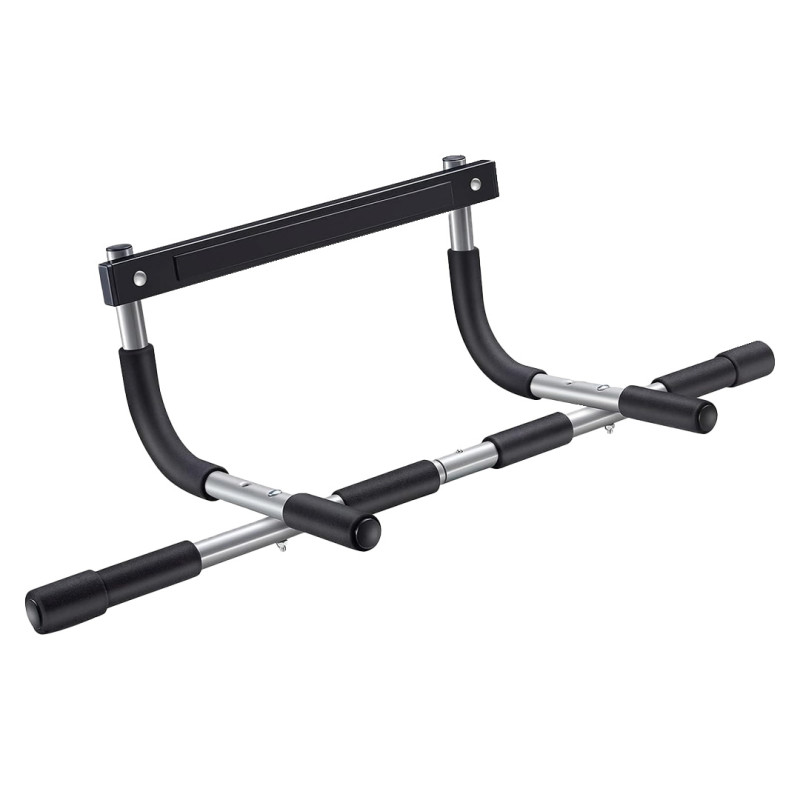Health
Cafe Rio Shredded Chicken (Copycat)

Our version of Cafe Rio Shredded Chicken is slow-cooked to perfection with a blend of savory spices perfect for a salad, burrito, quesadilla or enchiladas!
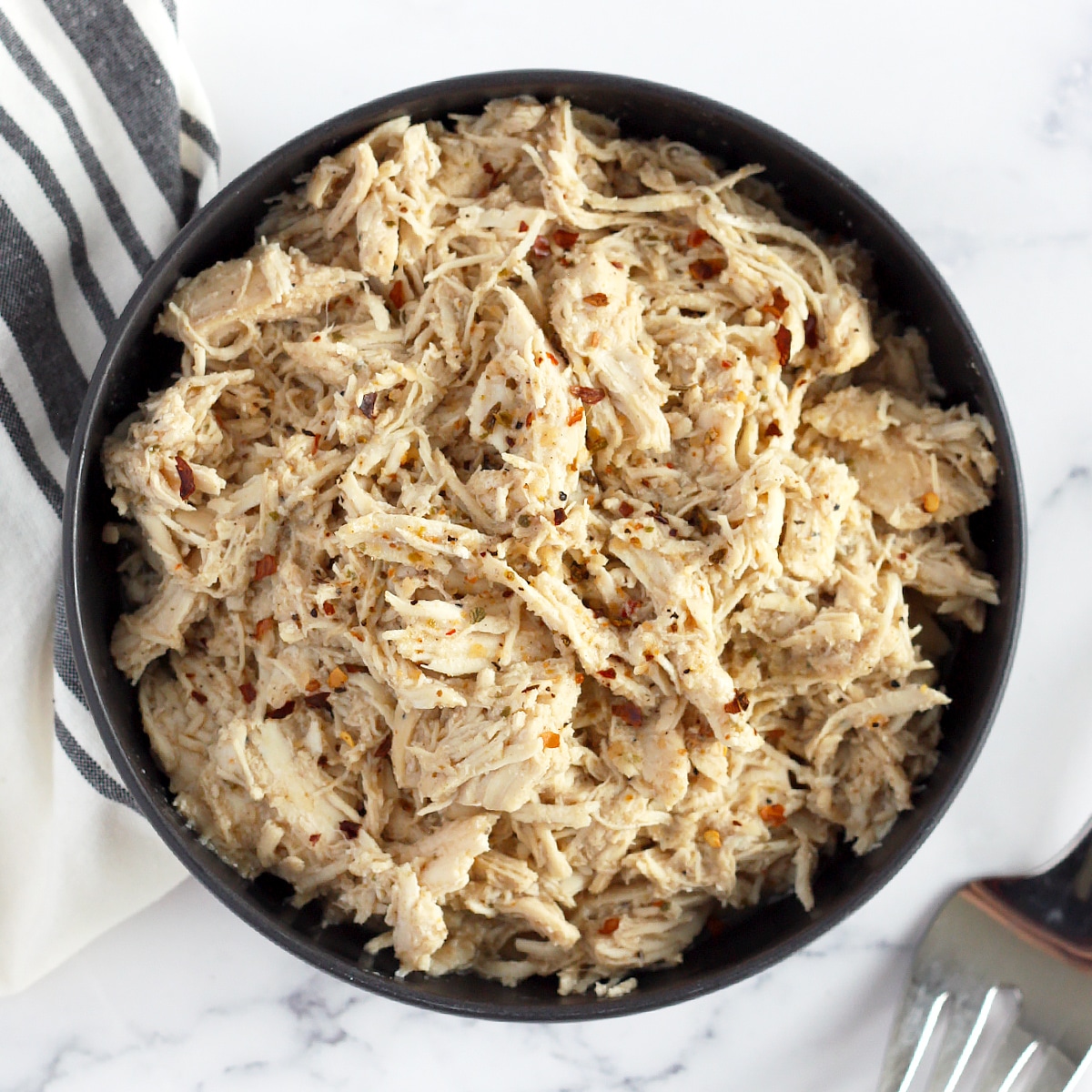
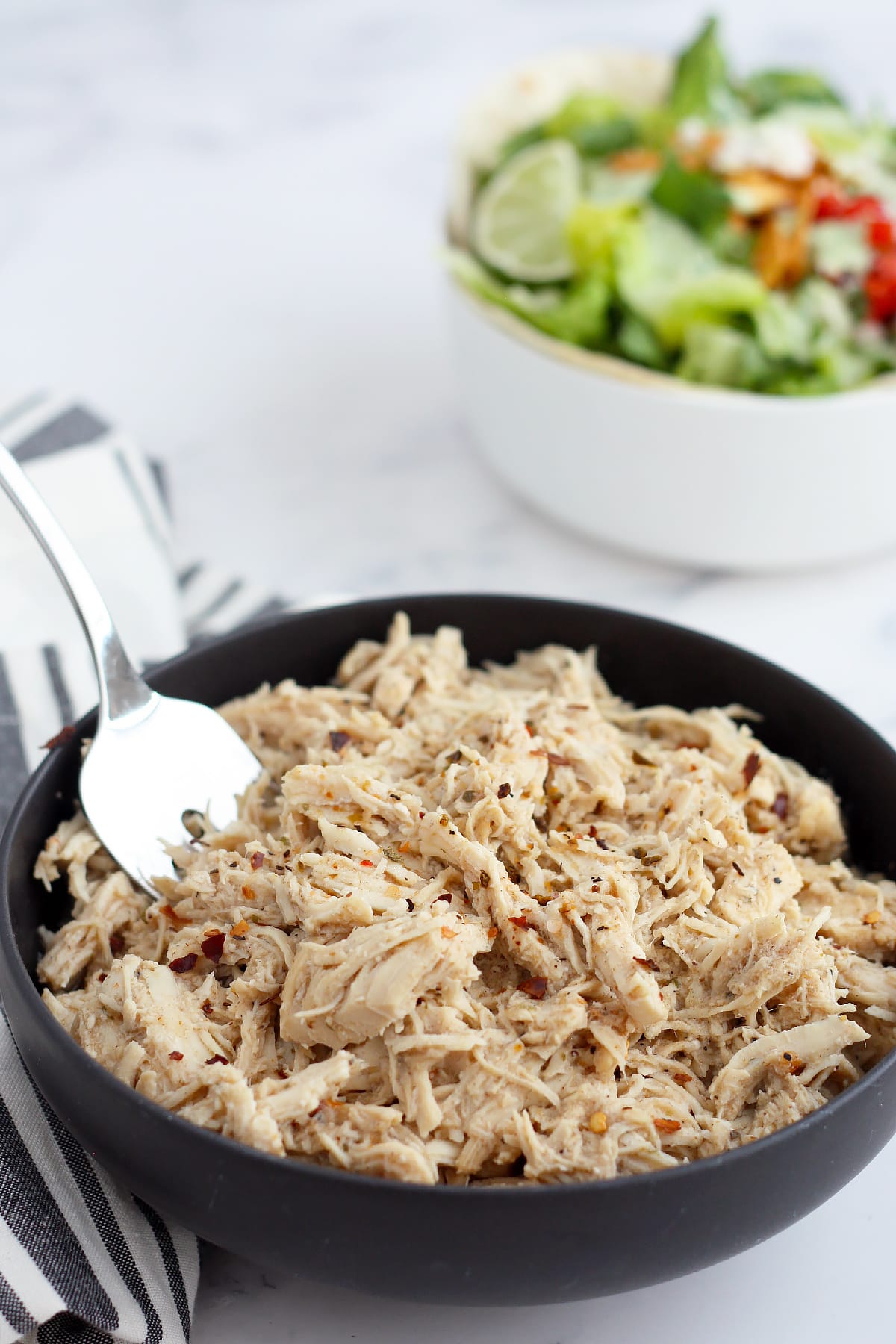
Crockpot Shredded Chicken
Crockpot or slow cooker shredded chicken is an absolute game-changer for busy families and meal preppers alike! It’s super convenient—you just toss the chicken in the crockpot with some delicious seasonings and let it cook low and slow while you go about your day. By the time dinner rolls around, you’ve got perfectly tender, juicy chicken that practically shreds itself.
It’s incredibly versatile, too! Use it for tacos, salads, quesadillas, wraps, burritos—the possibilities are endless. If you meal prep, this chicken is great to portion and keep in the fridge for up to 5 days. It also freezes really well and can be frozen for up to 3 months!
This recipe is inspired by one of our favorite local favorite restaurants – Cafe Rio! The seasonings on the chicken give it SO much flavor and it always turns out super moist. You have got to give it a try!
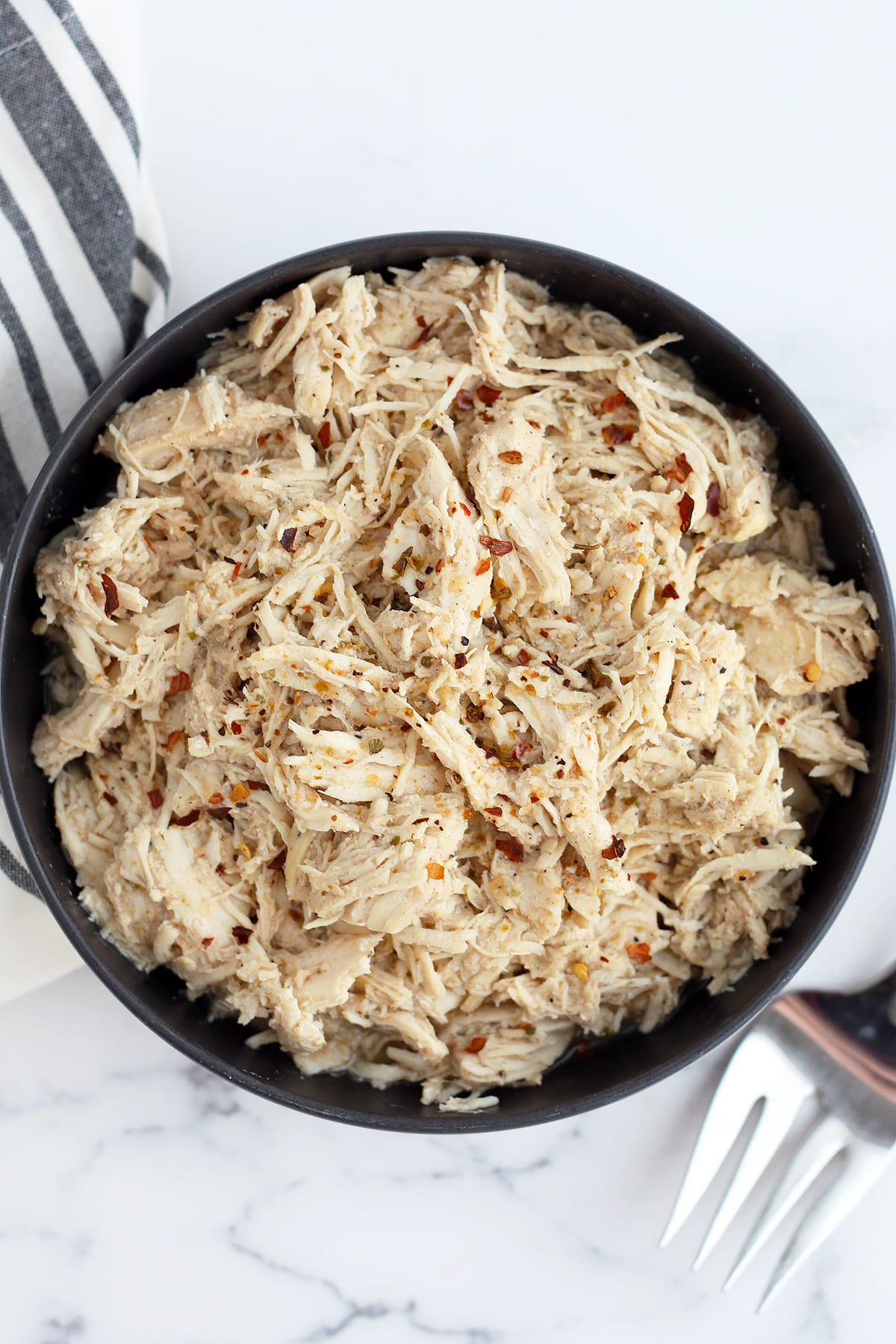
Ingredients for Cafe Rio Shredded Chicken
- Boneless Skinless Chicken. A lot of people want to know what cut of chicken is best for shredding. Boneless skinless chicken breasts and thighs are your best bet. Chicken breasts are leaner and shred easily, making them perfect for lighter dishes like salads and wraps. Chicken thighs are slightly fattier, giving a richer, juicier shredded chicken that’s fantastic for tacos, casseroles, and hearty soups. Both cuts cook beautifully in the crockpot, and so it really is just your preference!
- White Vinegar. The acidity of the vinegar helps to break down the chicken fibers, making the meat extra tender and juicy. It also adds a subtle tanginess that brightens up the overall flavor profile of the chicken without overpowering the other ingredients.
- Zesty Italian Dressing (dry). This seasoning mix is packed with herbs, spices, and a tangy kick that permeates the chicken as it cooks, creating a savory, well-seasoned dish. The combination of garlic, onion, red pepper flakes, and Italian herbs like oregano and basil gives the chicken a complex and delicious taste that can elevate simple shredded chicken into something extraordinary. It’s a convenient, all-in-one seasoning that saves you time from measuring out all of the ingredients!
- Dry Ranch Dressing Mix. Ranch dressing mix combines the flavors of buttermilk, garlic, onion, dill, and parsley that adds a creamy, herby flavor that everyone loves.
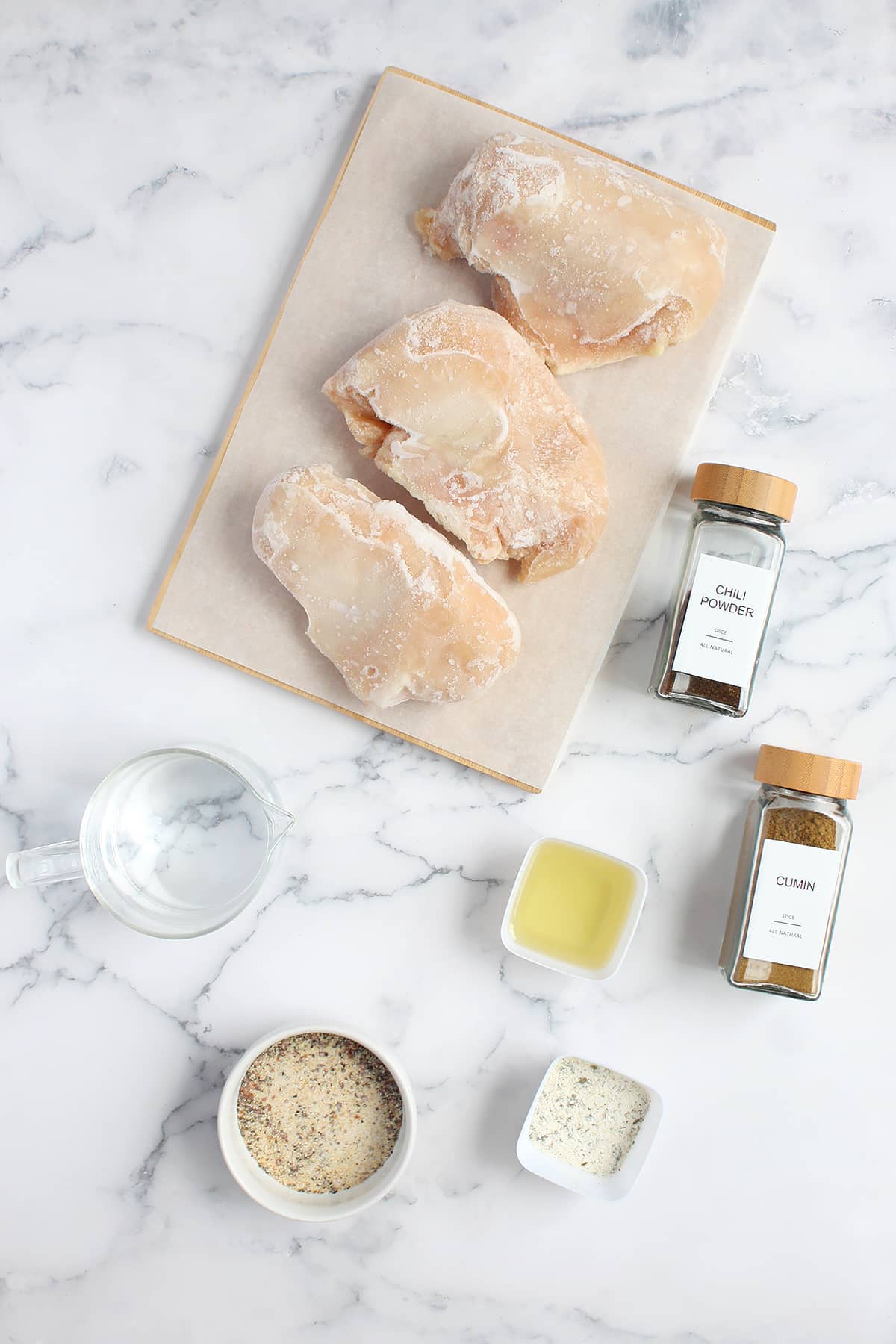
How to Make Crockpot Shredded Chicken Cafe Rio Style
There are just 3 simple steps to make this chicken!
- In a medium mixing bowl, mix vinegar, oil, zesty Italian seasoning packet, chili powder, cumin, and dry ranch seasoning.
- Spray the inside of your slow cooker with cooking spray and then add the chicken. Pour the dressing mixture over the top.
- Cover and cook on high for 4 hours. When it is done, shred the chicken with a fork.

Tips for Shredding Chicken
An easy hack for shredding chicken is to cool the chicken slightly after it is cooked. Put the chicken into a large bowl or the bowl of a stand mixer. Use a hand mixer or stand mixer fitted with the paddle attachment to shred the chicken. Start on low speed and gradually increase to medium-high speed. The chicken will shred quickly and evenly within a minute or two!
If you are wondering whether it is better to shred meat when its hot or cold, the answer is that its best to do it when its warm. It is harder to handle it while it’s scorching hot, but it doesn’t shred as easily when its cold. Allow it to cool slightly until it’s comfortable to handle, then proceed with shredding for best results.
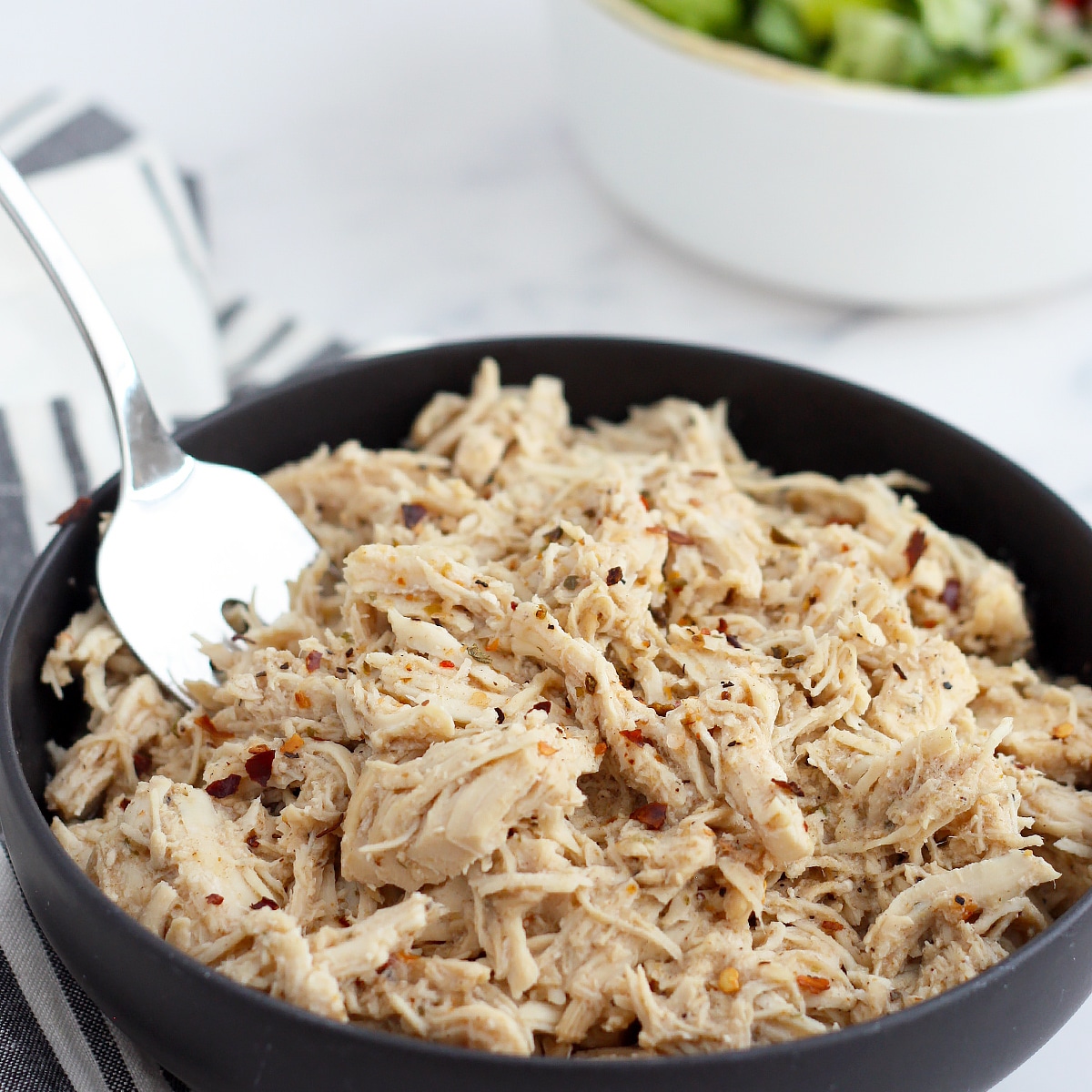
How to Make Cafe Rio Salad with Chicken
We love this chicken for lots of recipes, but our very favorite is Cafe Rio Salad! We like to layer:
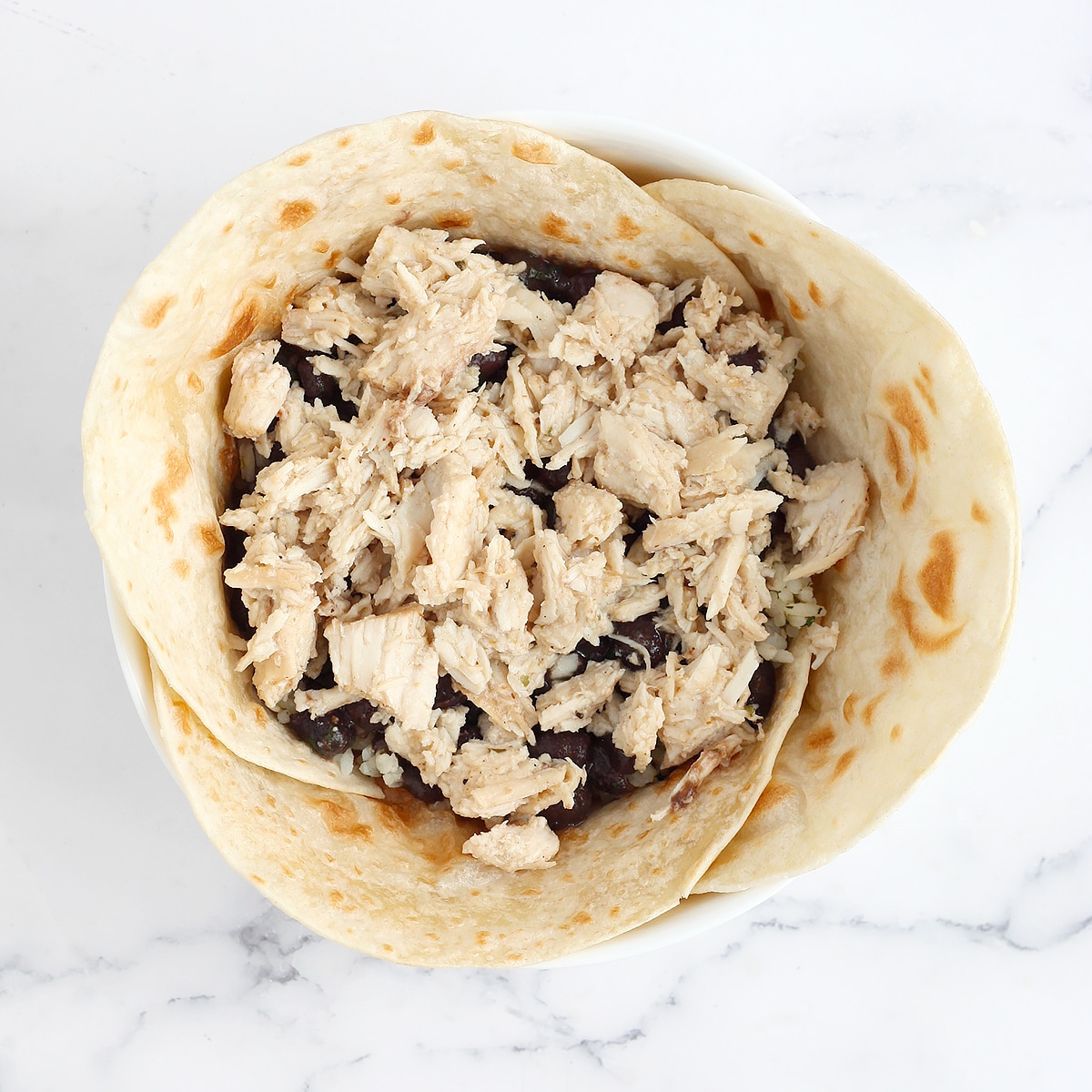
Then layer:
- Lettuce
- Pico or salsa
- Guacamole
- Cotja Cheese
- Cilantro Ranch Dressing
- Lime
- Tortilla Strips
- Fresh cilantro
Such a filling and delicious meal! Every time I make this, everyone in my family loves it!
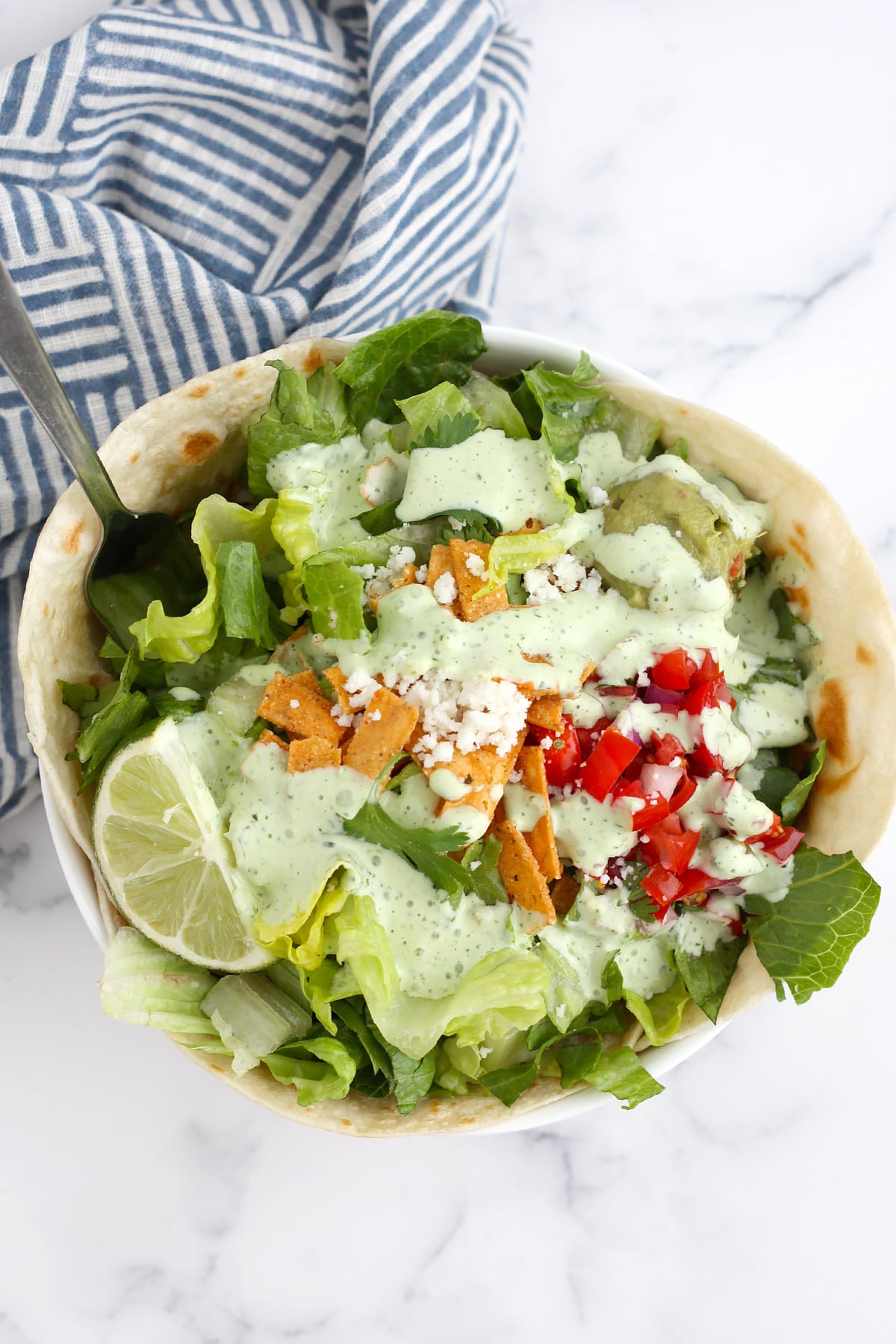
Recipes We Love Adding This Chicken To
Cafe Rio Shredded Chicken Copycat
Our version of Cafe Rio Shredded Chicken is slow-cooked to perfection with a blend of savory spices perfect for a salad, burrito, quesadilla or enchiladas!
Servings: 8 people
Calories: 206kcal
-
In a medium mixing bowl, mix vinegar, oil, zesty Italian seasoning packet, chili powder, cumin, and dry ranch seasoning.
-
Spray the inside of your slow cooker with cooking spray and then add the chicken. Pour the dressing mixture over the top.
-
Cover and cook on high for 4 hours (frozen chicken) or 2 1/2 – 3 hours (fresh chicken) When it is done, shred the chicken with a fork. Serve Cafe Rio style with a freshly cooked tortilla, chopped lettuce, beans, cilantro lime rice, pico de gallo, tortilla strips and cilantro lime dressing. Enjoy!
Calories: 206kcal | Carbohydrates: 3g | Protein: 24g | Fat: 10g | Saturated Fat: 1g | Polyunsaturated Fat: 2g | Monounsaturated Fat: 5g | Trans Fat: 0.04g | Cholesterol: 73mg | Sodium: 435mg | Potassium: 436mg | Fiber: 0.2g | Sugar: 0.05g | Vitamin A: 187IU | Vitamin C: 1mg | Calcium: 11mg | Iron: 1mg
www.superhealthykids.com

Natalie Monson
I’m a registered dietitian, mom of 4, avid lover of food and strong promoter of healthy habits. Here you will find lots of delicious recipes full of fruits and veggies, tips for getting your kids to eat better and become intuitive eaters and lots of resources for feeding your family.
Health
Longevity Cheat Sheet: 15 Ways to Live Longer

#1: Do not smoke cigarettes
- Benefit: +66%
- Scientific Rigor: 3/3
The most boring and yet most effective recommendation on the list shouldn’t surprise anyone. Don’t light toxic stuff on fire and then inhale it. Never-smokers vs. lifelong smokers have a whopping 66% reduction in mortality by age 79, and quitting after a long time of smoking can also retain much of this benefit.
#2: Take 8,000 to 12,000 steps per day
- Benefit: +51%
- Scientific Rigor: 2/3
There’s a reason fitness trackers target 10,000 steps per day: It’s the magic number that gets you most of the possible improvement. Increasing step count from 4,000 to 8,000 per day was associated with a staggering 51% reduction in death from all causes (all-cause mortality). Additionally, the intensity of the steps, like running vs. walking, didn’t matter at all. So 25 minutes on the elliptical might save you time in obtaining your step goal, but each step will benefit your longevity the same as a normal walk.
#3: Get sufficient sunlight
- Benefit: +50%
- Scientific Rigor: 1/3
This was higher up the list than expected, but it turns out that totally hiding from the sun might really hurt you. A study of 29,518 Swedish women found a 2X decrease in mortality associated with the highest amount of sun exposure. Note that we only gave this study a scientific rigor score of 1/3 because it was only women and took place in a northern climate. The correlation with sunbathing was seen in a country with a very low UV index, which should be interpreted with caution. However, many other studies have found that adequate sunlight is important for longevity, often related to Vitamin D and melatonin.
It’s obvious, but worth stating anyway: Too much sun can kill you. So don’t take this as advice to sit in the sun all day or to get sunburnt.
#4: Consider dry sauna a few times per week
- Benefit: +40%
- Scientific Rigor: 1/3
The study showcasing sauna benefits is from Finland, as many sauna aficionados might have guessed. The study only includes men and they’re all from Finland, but it’s the best study Guava Health found and it shows a substantial 40% reduction in all-cause mortality for those who used a sauna 4-7 times per week compared with once per week. Normally the study would include comparisons with zero saunas per week, but apparently that is unheard of in the sauna capital of the world. Keep in mind this is for dry saunas at around 175 degrees F, so does not necessarily apply to cooler saunas, infrared saunas, or steam rooms. However, a study linking infrared sauna with coronary improvements was found.
#5: Brush and floss your teeth nightly
- Benefit: +37%
- Scientific Rigor: 2/3
In addition to not aggravating the people within smelling distance, brushing and flossing each independently help you live longer, according to Guava Health’s chosen study on dental behaviors, conducted on adults 52 and older. Brushing and flossing every day compared to not every day was associated with a mighty 37% reduction in death during the study period. Yep, it wasn’t just something your parents bugged you about; it might actually kill you. A curious discovery in the article was that nightly brushing was most important, and was even better than morning and daytime combined. Flossing every day was best, but don’t worry if you’re lazy sometimes, there was still a noticeable benefit in flossing “sometimes,” just not as much.
#6: Minimize your stress levels
- Benefit: +34%
- Scientific Rigor: 2/3
Another commonly mentioned factor of faster aging, reduction of perceived stress, landed on the list with thorough scientific evidence. There is an entire industry around stress reduction, but if you’re looking to improve, you should first consider all the other health improvements on this list since many can reduce stress. Then, perhaps consider meditation or massage, which both have scientific evidence of stress reduction.
#7: If you drink alcohol, stay below 7 standard drinks per week
- Benefit: +31%
- Scientific Rigor: 3/3
A small amount of alcohol appears to give you slight protection from a few causes of death, notably myocardial infarction, but it’s still detrimental to overall longevity. For amounts below 100 grams (~7 drinks) per week, this study of 599,912 people found negligible effects on mortality. But, as you can see in the chart, those negative effects increased steeply above 7 drinks per week. Cutting down from 3 drinks per day to 1 drink could reduce your risk of death by 31%.
Keep in mind that if you don’t currently drink, it’s not recommended you start, since alcohol is known to be addictive and moderating your consumption might be difficult.
#8: Consider intermittent fasting
- Benefit: +26%
- Scientific Rigor: 1/3
Caloric restriction is one of the most effective and persistent methods of extending life across every species of life ever studied. Humans, however, have not been equally proven to live longer simply by reducing calories. There are some studies showing probable positive effects, such as the people who eat less in the Japanese islands of Okinawa, and across studies of fasting, which is a little different from calorie restriction. The best study Guava Health found wasn’t as thorough as hoped because it studied only 2,714 people and they were all recovering from a surgical procedure. But, it did show a very substantial reduction in mortality for those who routinely fasted for 5+ years compared with those who didn’t fast.
#9: Don’t consume too much sugar
- Benefit: +23%
- Scientific Rigor: 2/3
This study found that consuming only 10% of your daily calories as sugars compared with 20% or more offered a 23% reduction in mortality. The authors also found that it was more helpful to reduce sugar in beverages than it was in solid foods. Similar to avoiding excess sugar, avoiding high glycemic index foods can also be helpful to your longevity. Basically, eat more of the stuff like nuts and vegetables that don’t give you an instant dump of energy.
#10: Minimize processed meat
- Benefit: +19%
- Scientific Rigor: 3/3
Of all the meats you can eat, fish is one of the best for longevity, while red meat and processed meat are among the worst. That’s a generalization, of course — some fish are much healthier to eat than others (wild salmon is great), and the quality of red meats can vary significantly. The study Guava Health chose shows the biggest offender to be processed meat by far, but also indicates red meat is slightly harmful on average. So the official recommendation here is to avoid processed meat when you can, and either avoid red meat or be sure it’s high quality.
#11: Avoid bad air quality
- Benefit: +17%
- Scientific Rigor: 3/3
Bad air can come from many sources, including polluted cities, factories, forest fires, and high-heat cooking. Basically, it’s not healthy to burn stuff and then breathe it in. A massive study on U.S. cities found that each 10 µg/m3 decrease in PM2.5, a common measure of air pollution, reduces your mortality by 17%. This amount of reduction or more could be achieved by moving from a polluted city or factory to the suburbs. You can easily find your neighborhood’s current PM2.5 measurement online. If you’re in one of the world’s most polluted cities, your potential benefit could be much higher than 17%. And if you don’t plan on moving, you can also use an air purifier in your home and office, and use a car with HEPA filters to help minimize your exposure.
#12: Consider drinking coffee — even decaf
- Benefit: +15%
- Scientific Rigor: 3/3
Before modern science began adjusting for confounding factors, researchers used to think that coffee increased death rates. In reality, coffee drinkers were just more likely to also smoke cigarettes. After adjusting for this, recent studies show a non-trivial reduction in mortality for moderate coffee drinking of 2-4 cups per day. Furthermore, the improvement appears to remain even if you’re a slow metabolizer of caffeine, which is something you can test for with popular genetic test kits. Note that it’s coffee studied here, not caffeine. Decaffeinated coffee has shown similar results.
Remember, caffeine is a drug and is often addictive. It can be beneficial, but can also cause serious effects on your body, particularly at high amounts, so consult your doctor if you’re unsure.
#13: Eat 5 servings of fruits and vegetables per day
- Benefit: +13%
- Scientific Rigor: 2/3
More servings of fruits and veggies were associated with lower mortality, plateauing around ~5 servings. Notably, this does not include starchy veggies like corn, peas, and potatoes, nor does it include fruit juices. Increasing from 2 to 5 servings per day is what showed the 13% benefit being highlighted.
#14: Sleep 7-9 hours per night
- Benefit: +11%
- Scientific Rigor: 3/3
Many studies, including this meta-study, show increased mortality if you sleep too little. One difficulty is they had to combine different definitions of “short sleep” ranging from 4 to 7 hours, but the overall result was that staying above ~7 hours reduced mortality. A curious result of their study was that long sleep was even worse than short sleep. Somewhere in the range of 7-9 hours looked optimal for most studies, and although the studies were based on survey answers and couldn’t measure it, it’s common to recommend 7 hours of time actually asleep and not just laying in bed.
#15: Consider metformin
- Benefit: +7%
- Scientific Rigor: 3/3
Normally a drug targeting a specific disease would not be included in a longevity cheat sheet built for everyone, but metformin is a notable exception. In studies meant to understand its effectiveness at improving diabetes, the researchers were surprised to find that metformin reduced death from all causes for diabetics, even beyond non-diabetics, by 7%. This suggests that non-diabetics could benefit by even more than 7% by taking it. However, metformin is a prescription drug in the U.S., so Guava Health only recommends considering it through talking with your doctor, or other legitimate pathways if you live outside the U.S.
Bonus: Drinking more water doesn’t seem to help
- Benefit: +0%
- Scientific Rigor: 1/3
Strangely, no correlation was found between the amount of liquids consumed in a day and mortality. We all know that you’ll die within days if you stop drinking water, but perhaps the negative effects only appear with extreme dehydration, whereas all the study participants had full access to water.
This story was produced by Guava Health and reviewed and distributed by Stacker Media.
Health
Amazon's No. 1 Bestselling Pull-Up Bar Just Dipped Below $25, and Shoppers Say It's 'Worth Every Penny'

Men’s Journal aims to feature only the best products and services. If you buy something via one of our links, we may earn a commission.
If you’re even remotely interested in setting up a home gym, there’s one item that should be at the top of your shopping list: a pull-up bar. These simple, incredibly useful devices allow you to perform not only pull-ups, but all kinds of other exercises (dips, push-ups, and more), and they’re ideal for building upper body strength. That’s what makes the Ally Peaks Pull-Up Bar such a screaming deal: Now less than $25, you can get a great at-home workout that delivers real results.
The Ally Peaks Pull-Up Bar is now on sale for just $24 after an on-page coupon—a total discount of 25% off the normal $32 price. This well-made, highly versatile home workout tool has stacked up nearly 5,400 glowing five-star ratings from all kinds of fitness enthusiasts, and it’s currently the No. 1 bestselling strength training pull-up bar on Amazon.
Ally Peaks Pull-Up Bar in Silver 2, $24 (was $32) at Amazon
There are tons of pull-up bars for doorways on the market, but this is one of the best we’ve seen, especially at this price point. It stands out because of its durable 1.7mm-thick steel frame (including the top crossbar) that’s powder-coated to prevent rust, and it’s rated to hold up to 440 pounds. It’s also easy on your home thanks to durable silicone pads that protect your doorframe, and it even includes a second set of pads that you mount on the doorframe itself for extra protection. Finally (and perhaps most importantly), it’s designed for maximum workout versatility. It features hand grip areas for a variety of exercises, like wide pull-ups (great for working your shoulders), chin-ups, and neutral pull-ups. You can also use it on the floor for incline pushups, dips, and sit-ups, too.
Reviewers love that the Ally Peaks Pull-Up Bar has a solid feel when installed. One shopper called it “really sturdy” and said it “works well” in their home. Another shopper called it “stable and secure” and said they “feel 100% comfortable and confident on it.”
Others marvel at the versatility that comes with having this inexpensive piece of equipment. “Sturdy, versatile, and worth every penny,” one shopper said. “It has exceeded all my expectations. As someone who prioritizes fitness but doesn’t have the space for bulky equipment, this pull-up bar is a game changer for my home gym setup.” Another shopper agreed, saying, “So far I’ve been using it for wide pull-ups, close pull-ups, wide and close push-ups, and tricep dips.”
With its compact design and wide variety of uses, the Ally Peaks Pull-Up Bar is a must-have for any home fitness setup. At just $24, it’s a nearly unbeatable bargain, but act fast, because this killer deal won’t last forever.
Health
Montana Creates Emergency ‘Drive-Thru’ Blood Pickup Service for Rural Ambulances



Crystal Hiwalker wonders if her heart and lungs would have kept working if the ambulance crew had been able to give her a transfusion as the blood drained from her body during a stormy, 100-mile ride.
Because of the 2019 snowstorm, it took 2.5 hours to drive from her small town of Lame Deer, Montana, to the advanced trauma center in Billings.
Doctors at the Billings Clinic hospital revived Hiwalker and stopped the bleeding from her ruptured ectopic pregnancy. They were shocked that she not only survived after her heart stopped beating and she lost nearly all her blood, but that she recovered without brain damage.
The Montana State Trauma Care Committee, which works to reduce trauma incidents and to improve care, later realized the ambulance that carried Hiwalker had passed near two hospitals that stocked blood. What if Hiwalker had access to that blood on her way to Billings, committee members asked.
That realization, and question, inspired committee members to create the Montana Interfacility Blood Network, which they say is the first program of its kind in the U.S. The network allows ambulance crews to pick up blood from hospitals and transfuse it to patients on the way to the advanced care they need.
“We kind of came up with the idea of having a blood handoff — like driving through a fast-food restaurant drive-thru — and picking up blood on the way,” said Gordon Riha, a trauma surgeon at the Billings Clinic trauma center, where Hiwalker was treated. Riha said timely blood transfusions can prevent death or permanent brain injury.
The network is aimed at rural patients, who face elevated rates of traumatic injuries and death, said Alyssa Johnson, trauma system manager for the state of Montana.
“We have to get more creative. We don’t have a blood bank on every corner, and we don’t have a Level 1 trauma center on every corner,” Johnson said.
Network leaders say the program has helped at least three patients since it launched in 2022. They hope it will be used more in the future.
Hiwalker is excited about the program.
“I’m so glad that something like this got started, because it would save a lot of lives from where I live,” she said.
Hiwalker said she has heard about people bleeding to death after car crashes, gunshot wounds, and stabbings in her rural community. Johnson said work injuries, cancer, gastrointestinal problems, and childbirth can also cause serious bleeding.
The Montana trauma committee began discussing the blood network a few months after Hiwalker’s brush with death. First, it created a map of 48 facilities with blood banks. Then, it created guidelines for how hospitals, blood banks, ambulances, and labs must communicate about, package, transport, document, and bill for the blood.
The network is used only during emergencies, which means there’s no time to test patients’ blood types. So it uses only type O red blood cells, which can be transfused safely into most patients.
The receiving hospital — not the one that provided the blood — is responsible for billing patients’ insurance for the blood. The cost depends on how much blood patients need but typically ranges from several hundred dollars to more than a thousand, said Sadie Arnold, who manages the blood bank at Billings Clinic.
Arnold said blood must be stored in a lab and managed by professionals with specific degrees, clinical experience, and board certifications.
Some rural hospitals lack space for a lab or money to recruit these specialists, Arnold said. Or they may not need blood often enough to justify storing a product that can expire and — especially during the current national blood shortage — is needed elsewhere. The network uses blood that has a maximum shelf life of 42 days.
Rural hospitals that do store blood may have only small amounts on hand. A rural Montanan with severe bleeding experienced that firsthand when he went to the nearest hospital, which had only one unit of type O blood, according to a report on the blood network. But thanks to the new program, ambulance medics picked up more blood from a hospital halfway through an 80-mile drive to the trauma hospital.
Ideally, rural patients with serious bleeding would be transported by medical helicopters or airplanes outfitted for transfusions. But, as in Hiwalker’s case, flying can be impossible during bad weather. That can mean hours-long ambulance rides. Some towns in northeastern Montana, for example, are more than 250 miles away from the nearest advanced trauma center.
“This was truly designed for kind of that last-ditch effort,” Johnson said. When “we’re out of options, we’ve got to get the patient moving towards a larger center, and we can’t fly.”
The blood handoff may involve the ambulance stopping at the second hospital, Johnson said. But during one incident, a police officer picked up the blood and delivered it to the ambulance at a highway exit, she said.
Ambulances may also pick up a paramedic or nurse to provide the transfusion along the way, since many rural ambulance crews are staffed by emergency medical technicians, who in Montana aren’t authorized to do so.
Medics in other cities and states, including ones with rural areas, have started performing blood transfusions in ambulances and helicopters, said Claudia Cohn, chief medical officer of the national Association for the Advancement of Blood & Biotherapies.
She said researchers are also interested in the potential of using frozen and freeze-dried blood products, which could be helpful in rural areas since they’re easier to store and have longer shelf lives.
Johnson said the Montana Interfacility Blood Network is the only program she knows of specifically aimed at rural patients and involving ambulances picking up blood from hospitals along their routes. She said the network is gaining interest from other states with large rural regions, including Oregon.
Hiwalker said receiving a blood transfusion in the ambulance could have prevented her near-death experience and the trauma her husband faced from seeing her suffer as he rode in the ambulance with her. She’s glad her ordeal led to an innovation that is helping others.
KFF Health News is a national newsroom that produces in-depth journalism about health issues and is one of the core operating programs at KFF—an independent source of health policy research, polling, and journalism. Learn more about KFF.
USE OUR CONTENT
This story can be republished for free (details).
KFF Health News is a national newsroom that produces in-depth journalism about health issues and is one of the core operating programs at KFF—an independent source of health policy research, polling, and journalism. Learn more about KFF.
Subscribe to KFF Health News’ free Morning Briefing.
—
Previously Published on kffhealthnews.org
***
You Might Also Like These From The Good Men Project
Join The Good Men Project as a Premium Member today.
All Premium Members get to view The Good Men Project with NO ADS. A $50 annual membership gives you an all access pass. You can be a part of every call, group, class and community. A $25 annual membership gives you access to one class, one Social Interest group and our online communities. A $12 annual membership gives you access to our Friday calls with the publisher, our online community.
Register New Account
Need more info? A complete list of benefits is here.
—
Photo credit: unsplash
-

 African History5 years ago
African History5 years agoA Closer Look: Afro-Mexicans 🇲🇽
-

 African History5 months ago
African History5 months agoBlack History Facts I had to Learn on My Own pt.6 📜
-

 African History5 years ago
African History5 years agoA Closer Look: Afro-Mexicans 🇲🇽
-

 African History1 year ago
African History1 year agoMajor African Tribes taken away during the Atlantic Slave Trade🌍 #slavetrade #africanamericanhistory
-

 African History1 year ago
African History1 year agoCameroon 🇨🇲 World Cup History (1962-2022) #football #realmadrid #shorts
-

 African History5 months ago
African History5 months agoBlack History Inventors: Mary Kenner 🩸
-

 African History1 year ago
African History1 year agoPROOF AFRICAN AMERICANS AIN'T FROM AFRICA DOCUMENTED EVIDENCE
-

 African History1 year ago
African History1 year agoNo African pre-Columbus DNA? 🤯🤯 #history #mesoamerica #mexico #african


